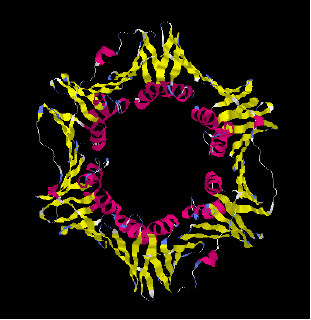




Biochemistry 238 - Biomedical Informatics 238
Computational Proteomics

Doug Brutlag
Biochemistry 238 - Biomedical Informatics 238
Computational Proteomics

Doug Brutlag
Course Description
Computational Proteomics is a graduate level or upper undergraduate level course focusing on the application of computational protein analysis to biological problems. The specific areas to be covered include protein sequence analysis and comparison (including protein sequence databases, sequence similarity search, protein motifs, protein families, protein classification, probabilistic models of protein families) protein structure (structure comparison and superposition methods, structural motifs, structure and domain databases) protein structure prediction (including secondary structure, homology modeling, threading and ab initio methods), protein-protein interaction databases and protein-protein interaction, protein microarray diagnostics and high-throughput diagnostics using mass spectrometry.
Course Requirements
There will be several homework assignments utilizing the tools described in the lectures. All homework and final projects will be submitted in electronic form as e-mail or e-mail attachments. A final paper will be required for the course that critically and constructively analyzes one of the areas related to the theme of the course. The final project may also present a novel application of existing tools or the development of some new or improved method. The final projects will be due Friday, March 14, 2008. There will be no extensions of this deadline. The homework will count for 35% of the final grade and the final project will count for 65%.
Course Availability
Biochemistry 238 will be taught in the Winter quarter 2007-2008.
Monday and Wednesday 2:15-3:30 in M114 Alway.
Registration
Registration is limited to 50 students. On campus students must register with the registra via AXESS. Off campus students must register with the Stanford Center for Professional Development.
Teaching Staff
Lee Kozar (kozar@stanford.edu) is the Associate Director of the Bioinformatics Resource at Stanford and is in charge of the computing facilities including software and databases that will be used for the homework. Questions concerning the programs, databases and other computing resources used in the course should be addressed to him.Kimberley Latta (klatta@stanford.edu) is the Administrator for the course. You should contact her for all administrative needs such as web page problems, student status, etc.
Lecture Syllabus
Protein sequence & structure databases Doug Brutlag Protein classification and families Doug Brutlag Protein motif databases Doug Brutlag Exploring protein structure space Michael Levitt Structure from Sequence: homology& threading Doug Brutlag Structure from Sequence: ab initio & molecular dynamics Doug Brutlag Protein folding dynamics Vijay Pande High throughput proteomic disease markers Chris Becker Identifying diagnostics with mass spectral methods Marshall Bern De novo protein sequencing with mass spec Marshall Bern Learning protein sequence motifs Doug Brutlag Learning protein structural motifs Doug Brutlag Protein-Protein Interactions Doug Brutlag Protein microarrays and detection of autoimmune disease PJ Utz Computational methods for protein microarrays PJ Utz Remote homology detection Doug Brutlag Proteomic diagnosis of trauma Ron Davis
Archived Tutorials
|
Topic |
Lecturer |
|---|---|
|
Progressive Pairwise Alignment Algorithm and Its Use by the SeqWeb BestFit Program |
|
|
Phylogenetic Analysis - Intro to Distance Methods to Study Evolutionary Relationships |
Bioinformatics Week Videos
https://cmgm.stanford.edu/classes/EBI-NCBI/videos/
Bioinformatics Resource Courses
http://cmgm.stanford.edu/classes/
** Last Updated December 28, 2007**